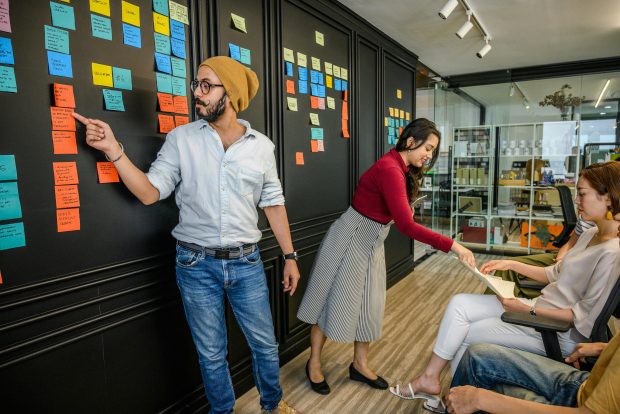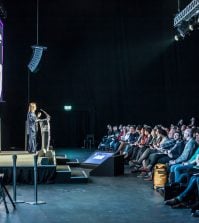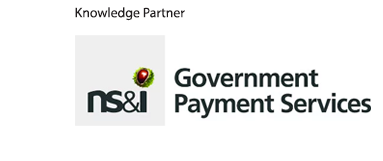People-powered insight: transforming policymaking through co-creation

Experts from the UK, Estonia and Brazil share best practice on harnessing people-powered insight in policymaking, examining how governments are working to understand citizens’ lived experiences and to turn their ideas into public services that really work
As governments confront increasingly complex and urgent challenges, one message is clear: they can no longer do it alone. Citizens, businesses and communities possess insight and expertise that, if tapped effectively, can radically improve the way policies are developed and delivered.
That was the clear message of Crowding in Innovation: How to Open Up Policy Development to People-Powered Insight, a recent Global Government Forum webinar held as part of its Innovation conference series. Senior public servants from the UK, Estonia and Brazil shared how opening up government to wider collaboration is not only possible – it’s essential.
Throughout the session, the panel emphasised that participatory policymaking isn’t just about consultation. Done well, it builds trust, strengthens policy outcomes, and unlocks innovation. Done poorly – or not at all – it risks leaving communities behind and missing opportunities for smarter governance.
Global Government Forum’s Innovation 2025 conference takes place on 25 & 26 March in London, and brings together government leaders from across the globe for discussions on transformation in government. It will look at what innovation means for civil servants, as well as how to create space for experimentation in government. Find out more and register here.
Crowding in diverse perspectives: lessons from the UK
For Sanjan Sabherwal, head of policy design and capability at the UK’s Department for Education, co-production methods are now fundamental. “These methods help address radical tech disruption, negotiate the use of commons by groups with competing interests, and design public services in a more mission-oriented way,” he said. “That’s where government is heading.”
While at Policy Lab UK, Sabherwal led a project in 2018 with the Maritime Coast Guard Agency to explore how autonomous vessels could operate in UK waters – a challenge still testing regulators worldwide. “We were thinking: how do we crowd in international examples of how regulators are dealing with this emerging technology? And how do we engage with the people developing it, who traditional regulators rarely speak to?” he recalled.
By engaging regulators from northern Europe and the US, alongside tech disruptors and harbour masters, the team broadened the agency’s understanding of the evolving regulatory landscape. “We dramatically increased the number of people the regulator could interact with,” Sabherwal said. “And most importantly, we brought in the perspectives of people who use those regulations every day.”
But not all challenges are technological. In another project, Policy Lab tackled declining sea bass stocks – a complex and contentious issue dividing recreational and commercial fishers. “We heard – although we didn’t see – that chairs had been thrown across the table when these communities came together,” Sabherwal said.
The team began with listening. They held pop-up research sessions in coastal pubs and ran large-scale online debates using Polis to map areas of consensus and contention. They then convened workshops with fishers, scientists and policymakers to co-design a fisheries management plan. “We had to build trust from the ground up – between stakeholders and with government,” he said.
A key part of that trust-building was the use of ethnographic tools. By capturing video footage of fishers in their everyday environments, the team was able to bring those lived experiences directly into policymaking spaces. “It really built empathy,” Sabherwal noted. “It helped us think from a different perspective about what we even do.”
Brazil’s citizen-driven innovation: collaboration at scale
Camila Medeiros, director of innovation at Brazil’s National School of Public Administration (Enap), shared how her country is embedding open innovation into public sector culture. “We consider open innovation as open government,” she said.
Since launching its Open Innovation Program in 2019, Enap has mobilised more than 3,000 people across Brazil – including public servants, start-ups, researchers and civil society groups. They partnered with over 100 organisations and launched more than 25 open innovation challenges in 2024 alone.
One flagship initiative is the Regional Development Open Innovation Program, a collaboration with Brazil’s Ministry of Regional Development. It tackles challenges ranging from building local government capacity to enhancing connectivity between regional cities. “We’ve already sparked 24 solution proposals,” Medeiros said. “And it’s demonstrating the power of open innovation and mobilising talent and expertise to solve complex problems.”
Co-creation in action: Click Co-Lab
Perhaps the most powerful example of Brazil’s people-powered approach is Click Co-Lab, an annual collaborative innovation lab. “We select a real-world challenge and invite citizens to co-create solutions alongside policymakers, experts and designers,” Medeiros explained.
In 2024, Click addressed public understanding of Cadastro Único, Brazil’s unified registry for social programmes. Many eligible citizens weren’t accessing benefits due to a lack of information. The response? A board game designed for schoolchildren aged 11-14, who in turn can serve as ambassadors to educate their families. “Instead of designing policies for citizens, we’re designing with citizens,” Medeiros emphasised. “We engage people that directly experience public services and generate solutions that are more human-centred, effective and sustainable.”
Reimagining government services: digital proof of life
Another success story is the redesign of Brazil’s ‘proof of life’ process for pensioners. Previously, beneficiaries had to make in-person visits to bank branches – exclusionary for those with mobility restrictions and a dangerous expectation during the pandemic.
Medeiros described how the process was digitised, enabling users to verify their status through facial recognition on a mobile app. “We protected millions of elderly citizens from unnecessary exposure to COVID-19,” she said. But the benefits went beyond safety. “The process is now faster and more accessible, particularly for the most vulnerable populations.”
Estonia’s e-Residency: a small nation thinking big
Estonia’s experience demonstrates how a small nation can lead in digital innovation. Sigrid Rajalo, director of innovation and technology at Estonia’s Ministry of Economic Affairs and Communications, described the genesis of the country’s e-Residency programme.
“It began as an open competition to find ideas for how Estonia could punch above its weight,” Rajalo said. One of the ideas to emerge was offering digital identities to non-residents, enabling them to establish businesses and access Estonia’s digital services. Today, there are more than 100,000 e-residents worldwide, and tens of thousands of new companies have been created.
Rajalo also highlighted Estonia’s participatory budgeting initiatives, where citizens submit and vote on projects for local authority funding. “These processes build trust,” she said. “And without trust, crowding in any kind of innovation is impossible.”
Borders, Brexit, and building trust: the UK Cabinet Office approach
Muiris Ó Floinn, head of border ecosystem of trust and innovation at the UK Cabinet Office, outlined his team’s work managing the UK’s border post-Brexit – a task requiring coordination between 28 government bodies.
Ó Floinn’s team launched the Ecosystem of Trust pilot and Border Trade Demonstrators to explore innovative technologies and user-centred approaches. “We spent a lot of time listening to people on the frontline,” he said. “What are the problems they face day to day, and how can we start there?”
One surprise was that traders prioritised predictability over cost. “If they know when goods will arrive, they can manage everything else,” Ó Floinn explained. “Without that insight, we might have chased the wrong solution.”
For Ó Floinn, neutrality was crucial. “Balancing competing interests – trade and enforcement – requires building trust,” he said. “Our role as a mediator, with no agenda, helped create that trust.”
Participatory policymaking: risks and rewards
The panellists agreed that participatory policymaking is not risk-free – but that the risks are necessary. “It’s not about de-risking,” Sabherwal said. “It’s about taking risks.”
Rajalo echoed the sentiment. “You can’t innovate without taking risks,” she said. “But you also need to be clear about expectations so you don’t let people down unexpectedly. People need to know what will happen with their insights.”
Ó Floinn highlighted another dimension: the importance of delivering impact and value. “It’s not our money we’re spending,” he said. “It’s public money. So it’s really important that when you spend it, you’re spending it on things that have impact and you’re not wasting it. You can save a lot of money by doing user research and by really understanding whether what you’re delivering is going to have an impact. It does take an upfront investment of time, but it’s worth it.”
Medeiros took the point further, explaining that co-creation not only ensures that public investments have impact, but also builds credibility and mitigates risks to public trust. Reflecting on Brazil’s digital proof of life redesign, she said: “Errors carry a high reputational and trust cost. We made mistakes at a critical moment during the pandemic, but because we were attentive to user feedback, we were able to correct quickly, mitigating reputational cost and restoring trust.”
Skills for a collaborative era
Crowding in innovation requires new skills from public servants. Medeiros identified empathy as a key behaviour developed through co-creation. “When public servants work alongside citizens, they start listening differently,” she said. Enap measures these behavioural changes through evaluations before, during and after projects.
Ó Floinn emphasised humility. “You have to be comfortable not being the person who knows the most,” he said. “Your job is to listen, not to have all the answers.” Curiosity and cross-sector awareness are also critical. “Look for solutions outside your policy area. They might be more relevant than you think.”
Building on this, Sabherwal highlighted the importance of diversity – not only in engaging the public but within government itself. “Innovation requires diversity,” he said, noting the risks of a monoculture in policy teams. “If you’ve got a monoculture, it might be good for some things – like drafting – but you end up drafting your way around challenges instead of facing the reality of the world.”
Advice for policymakers
The panellists offered clear advice to those seeking to crowd in innovation:
- Muiris Ó Floinn: “Spend more time understanding your users than building your first solution.”
- Camila Medeiros: “Adopt a design mindset. Start with understanding the problem deeply.”
- Sigrid Rajalo: “Think like a start-up: test, learn, fail fast, and keep collaborating.”
- Sanjan Sabherwal: “Build alliances – not in the immediate sphere of your like-minded folks, but expand the tent to be wider.”
Innovation demands collaboration
The future of policymaking is collaborative. As this discussion made clear, governments that open up to people-powered insight stand to deliver smarter, more effective and trusted policies.
“Stepping out of the office and co-creating with citizens doesn’t just lead to better solutions,” said Medeiros. “It builds state capacity and transforms institutional culture. It encourages public servants to tackle challenges differently – and better.”
The ‘Crowding in innovation: how to open up policy development to people-powered insight’ webinar took place on 11 February. Watch the webinar in full here.
Click here to find out more and register for Innovation 2025





















